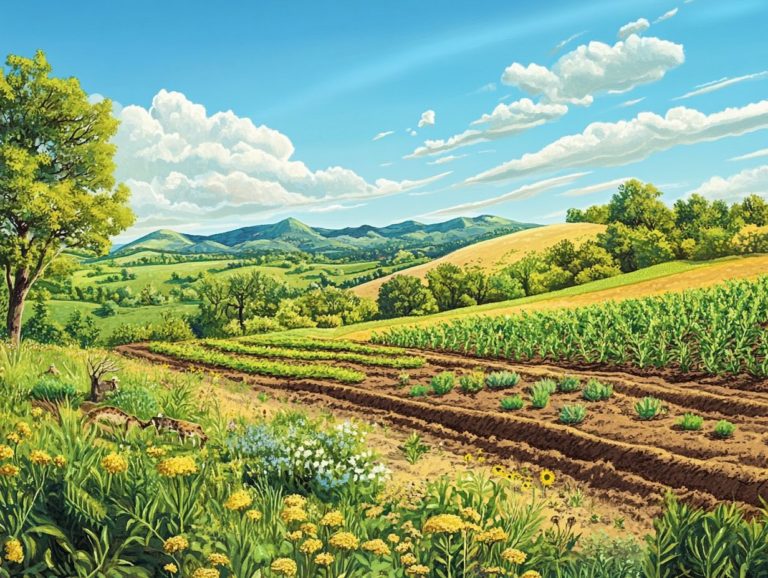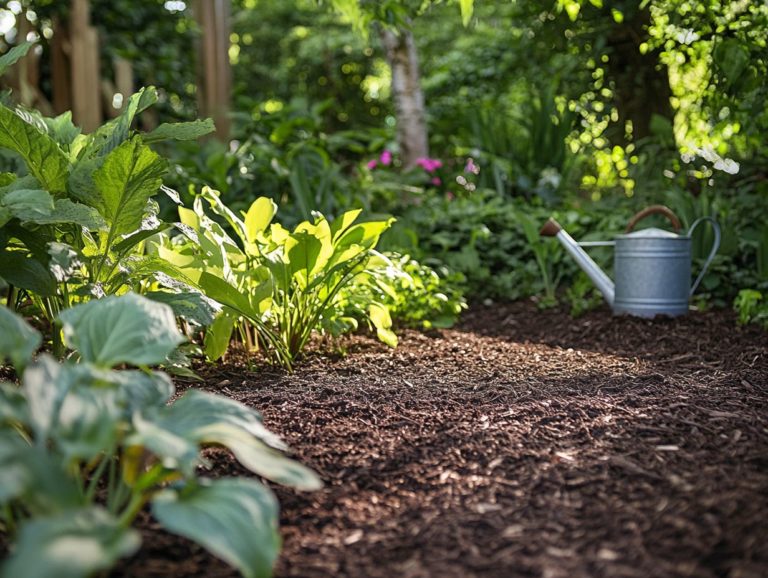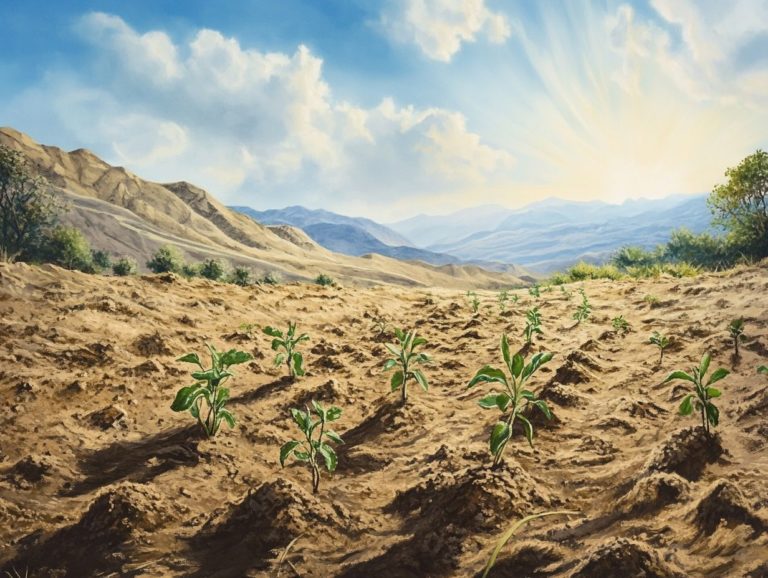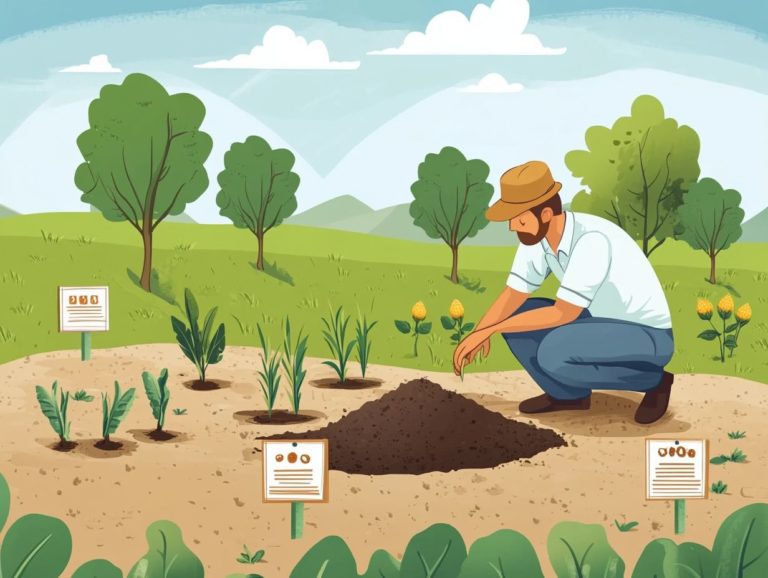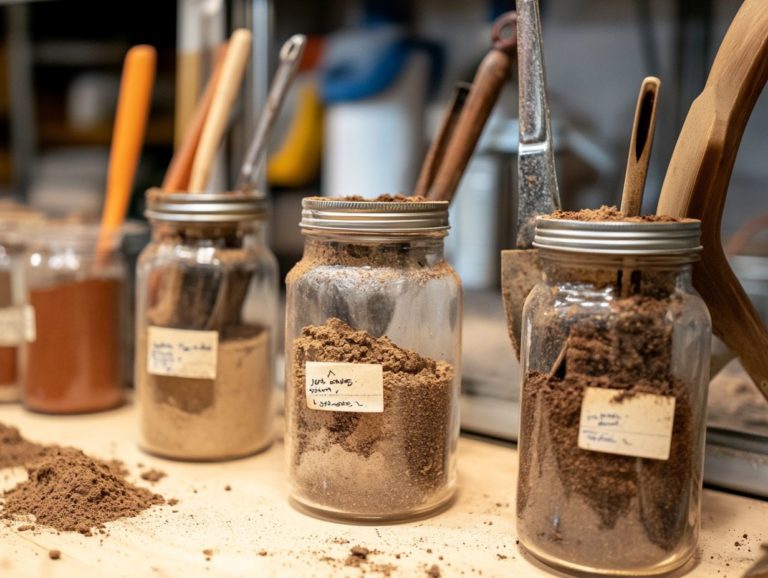How Soil Structure Affects Water Conservation
Soil structure is essential in our ecosystem, especially for water conservation. Understanding how the arrangement of soil particles impacts water retention and helps prevent erosion can significantly influence your agricultural practices and promote environmental sustainability.
This article explores the factors affecting soil structure, including the different types of soil particles and the crucial role of organic matter. You’ll discover practical methods to enhance soil structure and learn best practices for conserving water in agriculture.
Join us as we examine the vital connections between soil health and effective water management.
Contents
- Key Takeaways:
- The Importance of Soil Structure in Water Conservation
- Factors that Influence Soil Structure
- Improving Soil Structure for Water Conservation
- Best Practices for Water Conservation in Agriculture
- Frequently Asked Questions
- How does soil structure affect water conservation?
- What are the benefits of soil with good structure for water conservation?
- How does soil compaction affect water conservation?
- Can soil structure impact water quality?
- How can we improve soil structure for better water conservation?
- What are some potential consequences of ignoring soil structure in water conservation efforts?
Key Takeaways:

- Soil structure plays a crucial role in water conservation by affecting water retention and preventing erosion.
- The type of soil particles and the presence of organic matter and soil microbes are key factors that influence soil structure.
- Use cover crops and crop rotation to improve soil structure and save water.
The Importance of Soil Structure in Water Conservation
Soil structure is integral to water conservation, as it directly affects soil moisture retention, water-holding capacity, and overall soil health. Understanding the impact of soil erosion on water conservation is crucial, as the arrangement of soil particles creates pathways for water entry, enhancing water use efficiency, especially during extreme weather events.
Effectively managing soil structure is essential not just for sustaining productive agricultural practices but also for ensuring a reliable water supply, a cornerstone of conservation agriculture. This is especially crucial in regions like the Midwest, where varying soil textures and structures can significantly influence forage production and nutrient management.
How Soil Structure Affects Water Retention
The structure of soil is a crucial factor in determining its ability to retain water, which directly influences the water levels essential for crop growth.
By understanding this relationship, you ll see how different soil textures like sandy, loamy, or clayey play a pivotal role in moisture retention. Sandy soils drain well but struggle to hold onto water due to their larger particles and pore spaces. In contrast, clayey soils can retain moisture effectively, yet they may experience drainage issues.
Incorporating organic matter significantly enhances soil structure, as studies from the Journal of Soil and Water Conservation highlight. This addition fosters the creation of clumps that improve water-holding capacity, enriching moisture levels and ultimately supporting strong crop development and sustainability.
Role of Soil Structure in Preventing Erosion
Soil structure plays a crucial role in preventing erosion. Well-structured soils hold together better, reducing susceptibility to water runoff and ensuring that water remains available for plants.
Healthy soil strengthens the landscape against erosion, enhances biodiversity, and supports overall plant health. However, compaction often caused by heavy machinery can severely degrade soil structure, leading to increased runoff and erosion during storms.
On the flip side, adopting conservation agriculture practices, such as no-till farming and cover cropping, can significantly improve soil porosity and organic matter content. For instance, planting cover crops like clover creates a protective layer that reduces surface erosion and boosts soil health.
By integrating these practices, you pave the way for a sustainable agricultural approach that preserves soil integrity and fosters a thriving ecosystem.
Factors that Influence Soil Structure
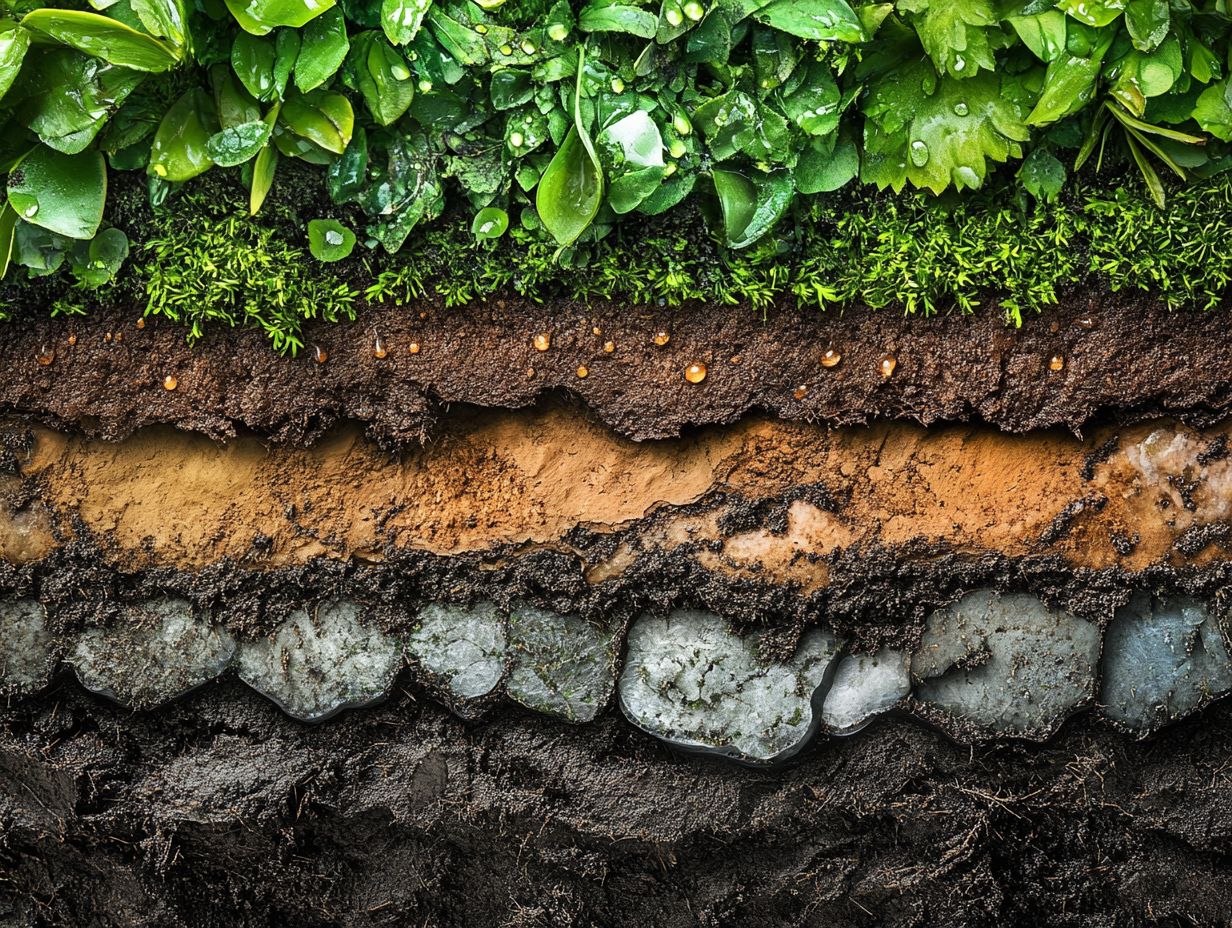
Several factors influence soil structure, including the types of soil particles, the amount of organic matter, soil depth, and the degree of soil compaction. Each of these elements plays a vital role in determining the overall health of your soil.
Types of Soil Particles
Soil is a fascinating blend of various particle types, including sand, silt, and clay. Each plays a crucial role in shaping soil texture and structure.
These particles vary significantly in size and characteristics. Sand is the largest of the trio, offering excellent drainage but lacking in water retention. This can be a drawback during dry spells.
Silt particles, on the other hand, sit in the middle. They hold moisture more effectively and are often more fertile, boosting agricultural productivity. Then there s clay, the smallest of them all, which tends to create dense layers that impede water movement. While this can lead to poor drainage, it also means superior moisture retention.
Grasping the balance among these particles is vital for effective soil management. The intricate interplay between them influences water availability and impacts crop health across various ecosystems.
Organic Matter and Soil Microbes
Organic matter and soil microbes are crucial players in enhancing soil health and structure. This is vital for effective water conservation.
When you incorporate organic matter into your soil, it helps establish a stable crumb structure, which refers to the way soil particles clump together, improving air and water movement. This promotes aeration and enables better root penetration.
As soil microbes seek their sustenance, they break down this organic material, releasing essential nutrients back into the soil. This process is important for recycling nutrients.
Take conservation agriculture practices, for example. Techniques like cover cropping and minimal tillage not only help maintain organic matter levels but also nurture a vibrant microbial community. These approaches significantly improve the soil s ability to retain water, making it more resilient during dry spells and decreasing reliance on synthetic fertilizers.
Improving Soil Structure for Water Conservation
Transforming your soil structure can make a world of difference for water conservation. It enhances soil health and promotes sustainable agricultural practices, such as conservation agriculture and the strategic use of cover crops.
By focusing on these elements, you can create a resilient ecosystem that supports both productivity and environmental stewardship.
Methods for Enhancing Soil Structure
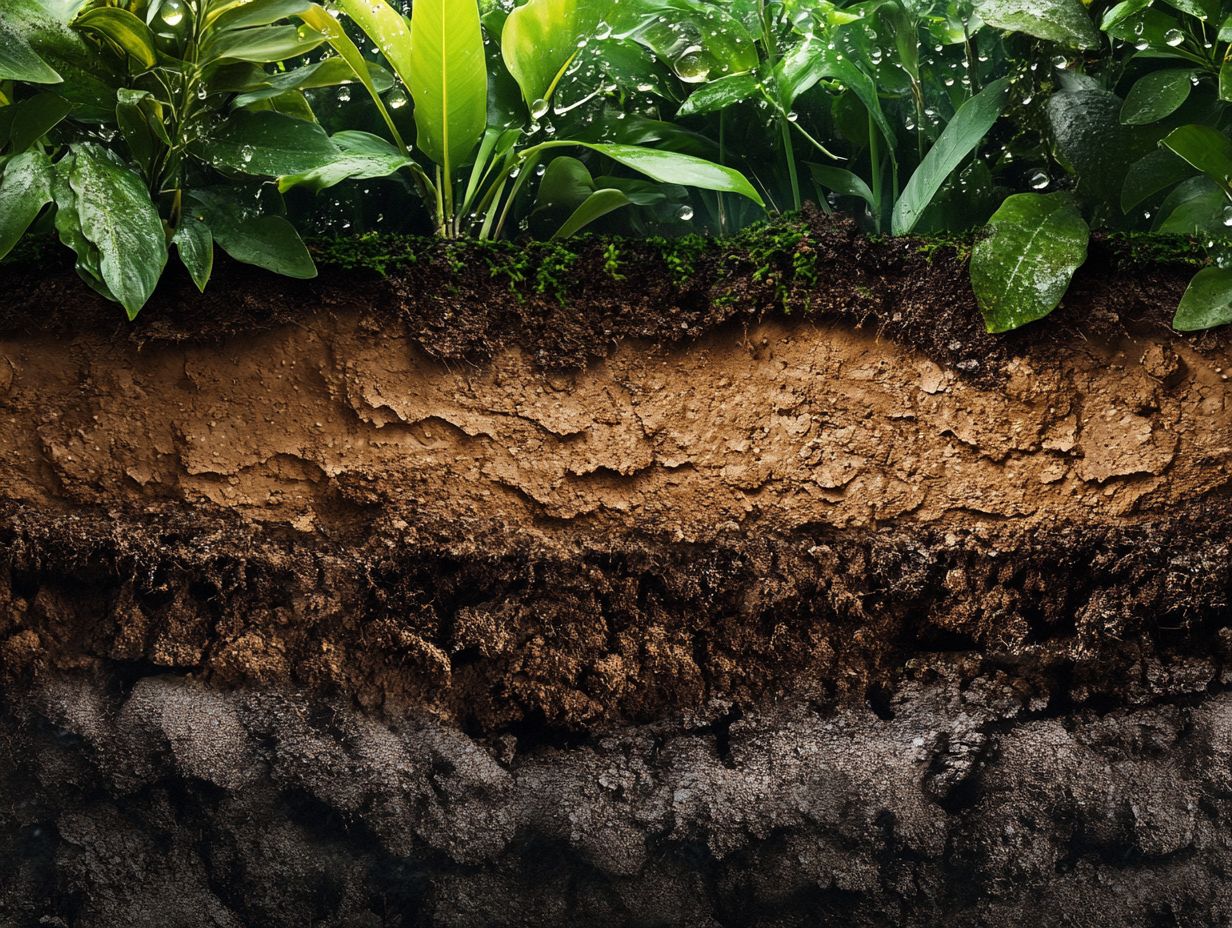
To enhance soil structure, explore various methods such as:
- Reducing soil compaction
- Increasing organic matter
- Implementing conservation agriculture techniques
By incorporating practices like cover cropping and crop rotation, you can significantly elevate soil health. These approaches foster the development of a rich organic layer and promote biodiversity, which is vital for resilient ecosystems.
Integrating minimal tillage practices helps maintain soil structure and mitigate erosion. Federal incentives like grants and subsidies can support you in adopting these beneficial techniques.
Act now to embrace these changes! You can contribute to water conservation, allowing moisture to penetrate deeper into the soil and ultimately promoting healthier crops and sustainable land use.
Best Practices for Water Conservation in Agriculture
Implementing best practices for water conservation in agriculture is essential for preserving soil health, improving nutrient management, and achieving sustainable forage production alongside optimal crop yields.
This proactive approach safeguards your resources and ensures a thriving agricultural environment that benefits both you and the ecosystem.
Techniques for Preserving Soil Structure
Preserving soil structure is vital for maintaining soil health. It enhances water conservation in agricultural systems.
Adopt conservation practices to reduce soil compaction. Techniques like minimal tillage lessen soil disruption and improve water infiltration.
Cover cropping is another beneficial practice. It increases organic matter and shields the soil from erosion.
Diversifying crop rotations and adding trees to your crops create resilient ecosystems. These methods contribute to a sustainable future.
Using Cover Crops and Crop Rotation
Using cover crops and practicing crop rotation boosts soil health. These methods are essential for effective water conservation.
They preserve soil structure and nurture vibrant ecosystems. By adding various plant species, you encourage biodiversity, which is vital for nutrient-rich soils.
Cover crops anchor the soil, greatly reducing erosion risks. Together, these sustainable practices improve water retention and crop resilience.
Ultimately, this approach supports long-term agricultural productivity. It ensures your farming endeavors thrive for years to come.
Frequently Asked Questions
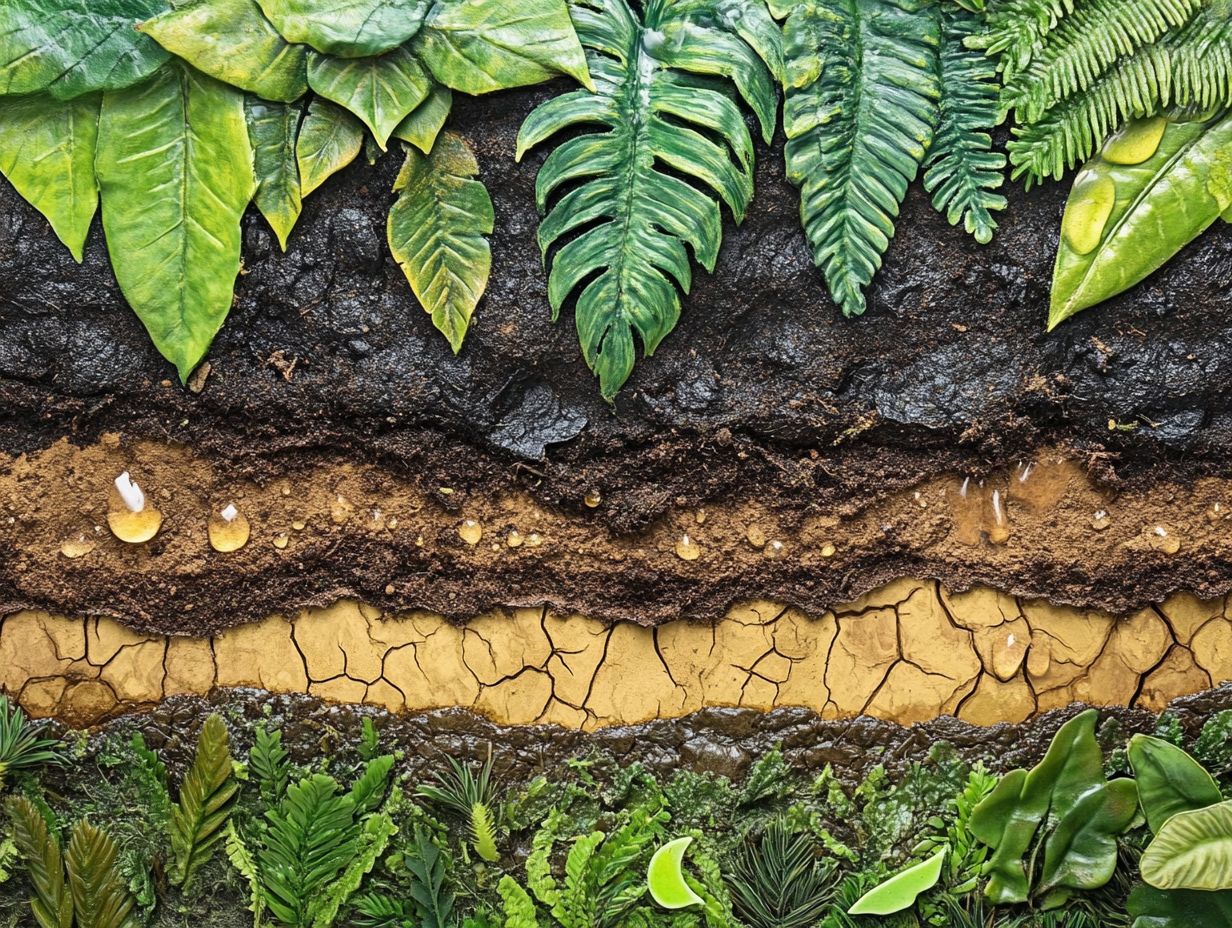
How does soil structure affect water conservation?
The structure of soil plays a crucial role in water conservation. Different soil types have varying abilities to hold and retain water.
What are the benefits of soil with good structure for water conservation?
Soil with good structure acts like a sponge. It absorbs and holds water for plants, preventing runoff and allowing better infiltration.
How does soil compaction affect water conservation?
Soil compaction decreases the water that soil can hold. This leads to shortages and drought conditions, making proper soil structure essential.
Can soil structure impact water quality?
Yes, soil structure affects water quality. Poor structure may fail to filter out pollutants, leading to contaminated water sources.
How can we improve soil structure for better water conservation?
You can improve soil structure by adding organic matter and reducing compaction. Implementing practices like cover cropping and reduced tillage is beneficial.
What are some potential consequences of ignoring soil structure in water conservation efforts?
Ignoring soil structure can lead to water shortages and decreased quality. It may also cause erosion and loss of topsoil, impacting conservation efforts.

